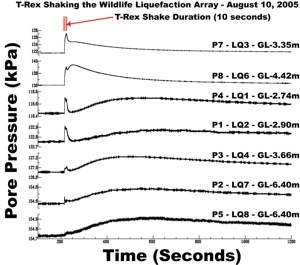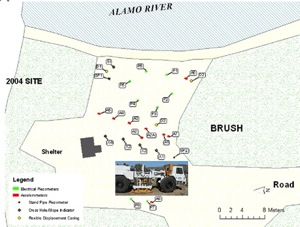- NEES Project Warehouse: https://nees.org/warehouse/project/168
- NSF Award Abstract:
- USGS Abstract:
 A joint experiment between the USGS/NEHRP external grants program (USGS Grant number 04HQGR0073) and the NSF/NEHRP George E. Brown Jr. NEES program (NSF award number CMS-0402490) began this week.
A joint experiment between the USGS/NEHRP external grants program (USGS Grant number 04HQGR0073) and the NSF/NEHRP George E. Brown Jr. NEES program (NSF award number CMS-0402490) began this week.
NEES@UTA has been shaking the Wildlife Liquefaction Array site using one of the NEES mobile shakers, recording data on temporary sensors as well as the permanent array at the site operated by NEES@UCSB.
The data that was collected over a two week period will help us improve our understanding of pore pressure generation during ground shaking. This unique data will be used for years to come by researchers and their students developing and improving ground motion simulation techniques that include the effects of pore pressure.
Movie of T-Rex Shaking: wlashake00.mov
 Multi-agency, Multi-disciplinary Collaboration
Multi-agency, Multi-disciplinary Collaboration
This experiment is a great example of multi-agency and multi-disciplinary collaboration addressing important scientific problems. Through the combined resources of these different agencies and institutions, we are able to accomplish far more. This is a case where the whole is clearly greater than the sum of the parts....
A dissertation on the subject of in-situ liquefaction was completed by Brady Cox of the University of Texas. Dr. Cox is currently Assistant Professor of Civil Engineering at the University of Arkansas. Development of a Direct Test Method for Dynamically Assessing the Liquefaction Resistance of Soils In Situ.
Collaborating Organizations
- USGS: http://www.usgs.gov
- NEES: http://www.nees.org
- HPWREN: http://hpwren.ucsd.edu
- University of Texas: http://nees.utexas.edu
- NEES @ UCSB: http://www.nees.ucsb.edu
Our continued thanks to the High Performance Wireless Research and Educational Network (HPWREN) for their facilities and support that make this research possible: http://hpwren.ucsd.edu/



